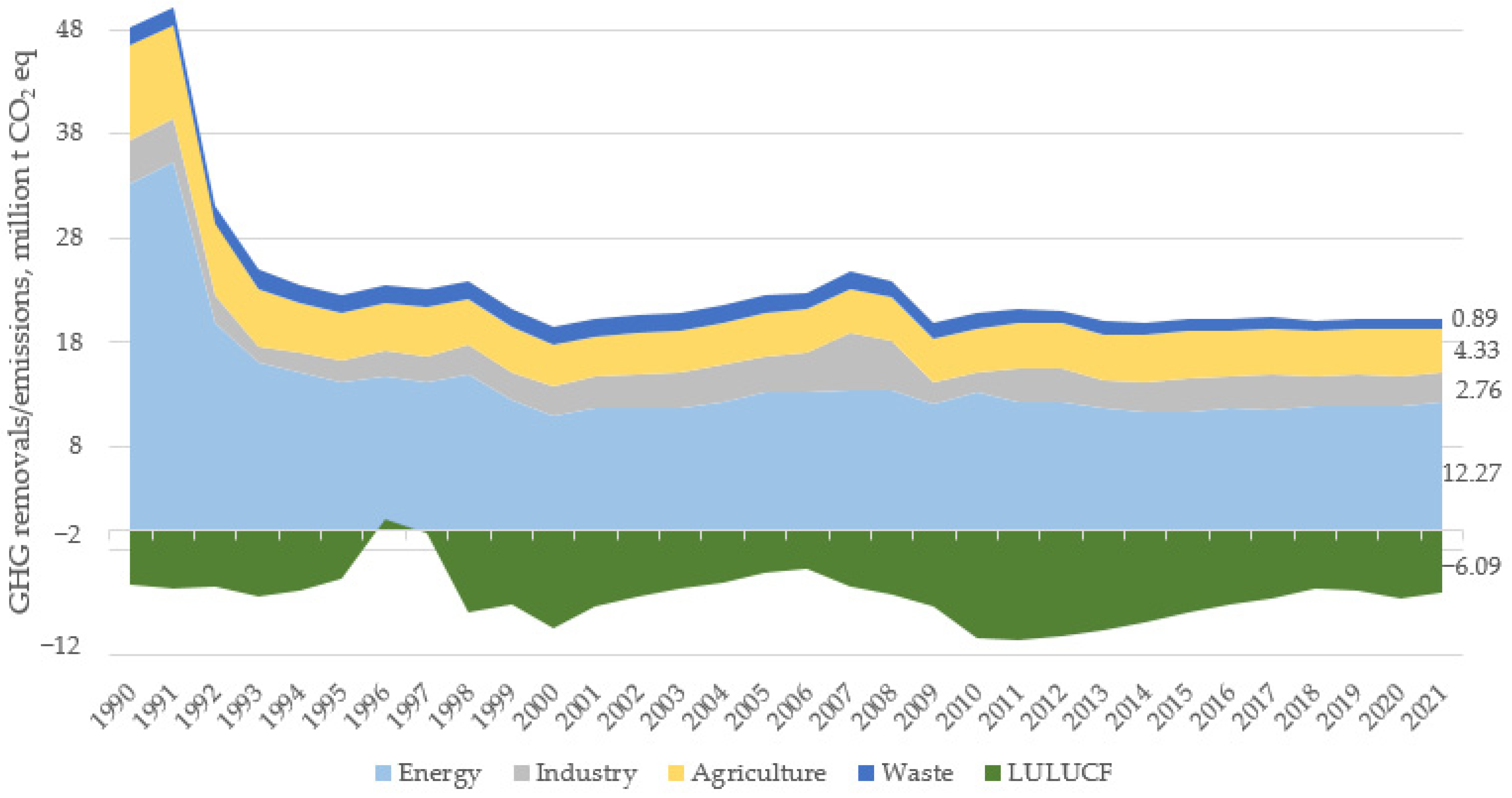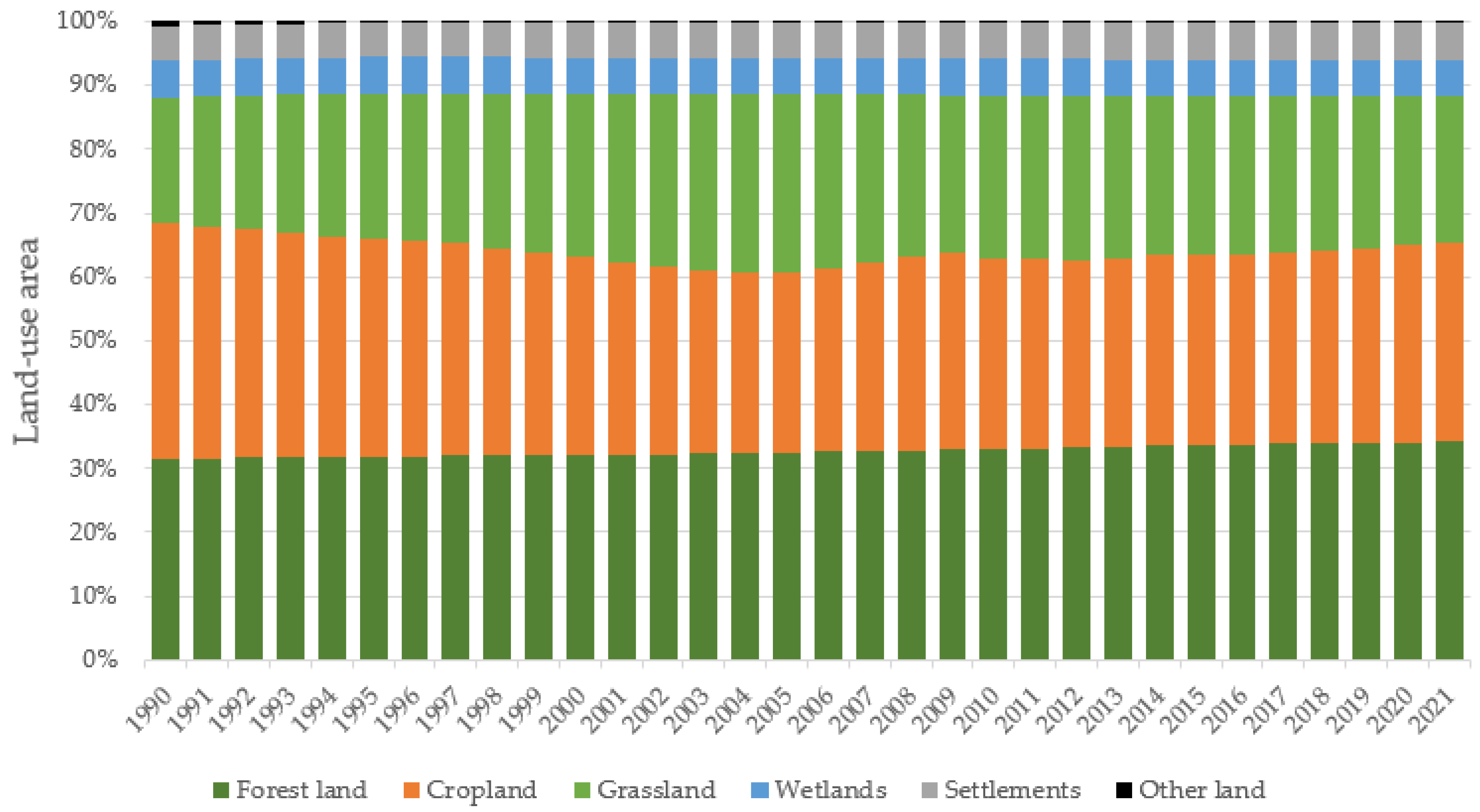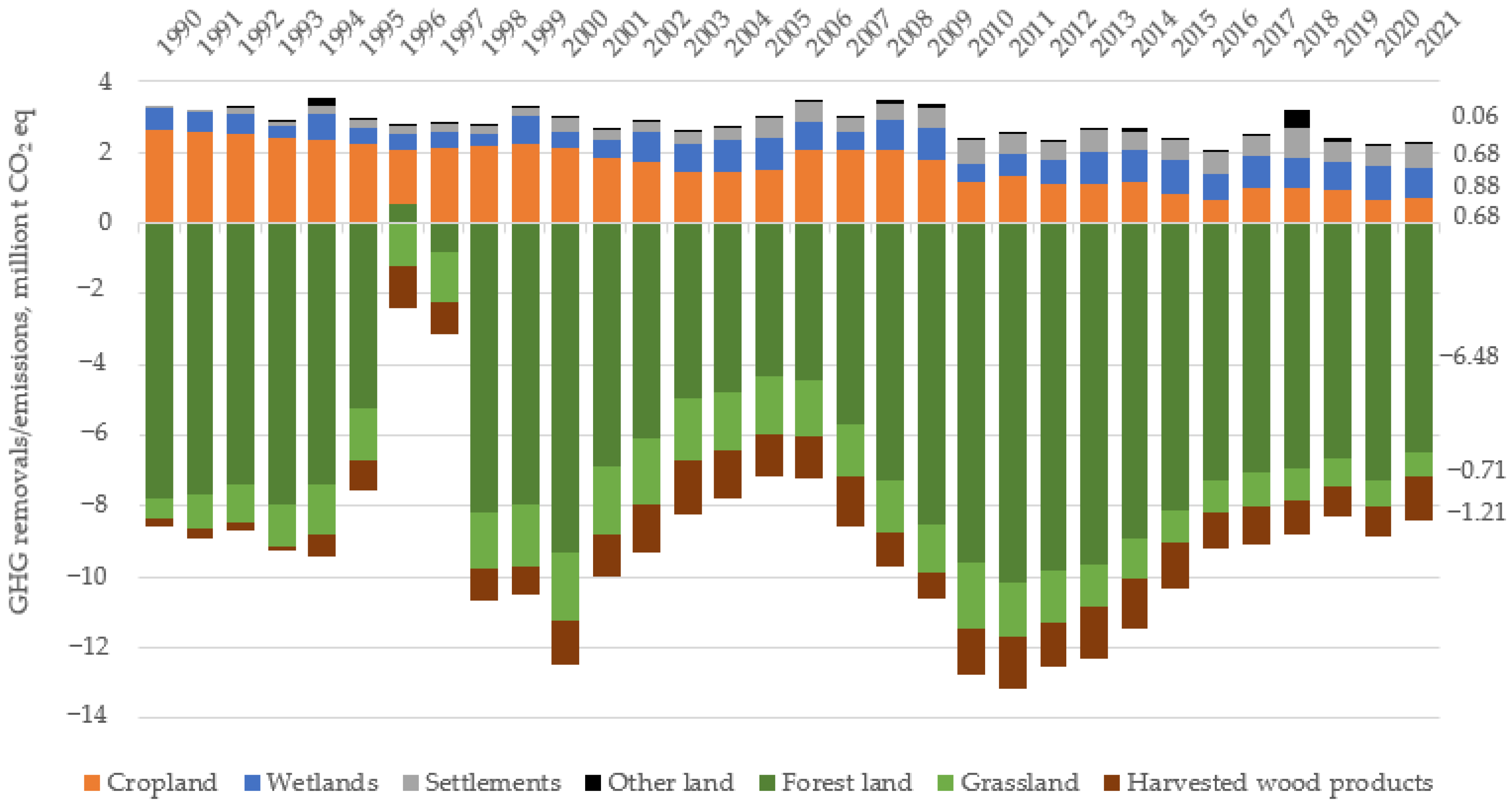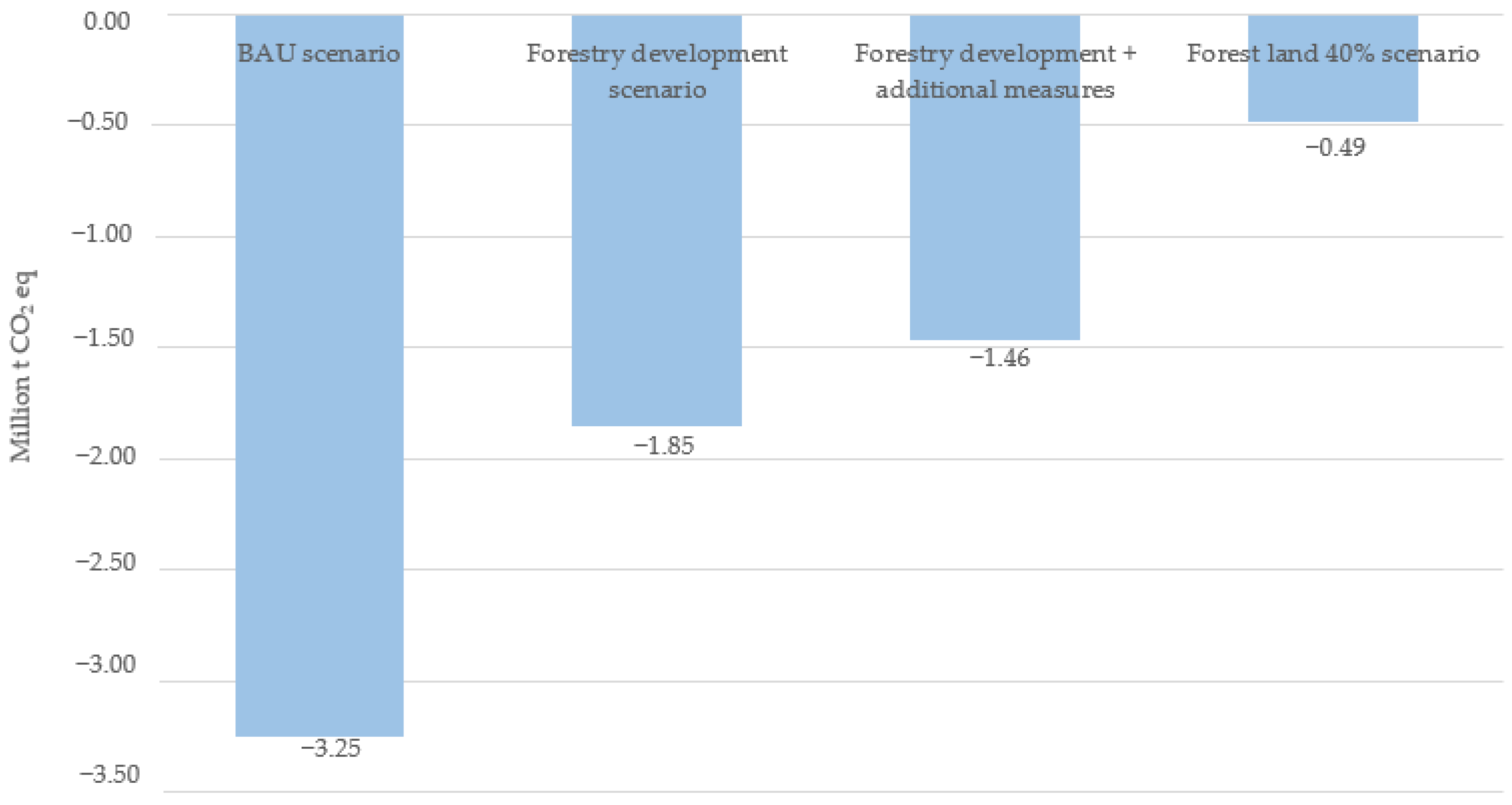Impact of Land-Use Changes on Climate Change Mitigation Goals: The Case of Lithuania
Abstract
1. Introduction
2. Methods
2.1. Land-Use Changes and National GHG Emissions
2.2. Projections of Greenhouse Gas Emissions and Removals under Different Scenarios
- The business-as-usual (BAU) scenario (scenario I) contains the assumption that the recently observed forest area will increase to reach 34.4% forest-area coverage in 2030 and 34.5% forest-area coverage in 2050 (3200 ha annually) according to the national forestry sector development plan for 2012–2020 [39];
- The forestry development scenario (scenario II) includes the assumption of a significant forest-area increase (from 34.1% in 2021 to 35.1% in 2030 and 35.3% in 2050)—8000 ha annually, including both human-induced afforestation and natural forest expansion, as indicated in Policies and Measures and Projections of Greenhouse Gas Emissions in Lithuania [30];
- The forestry development + additional measures scenario (scenario III) makes additions to scenario II, including preliminary measures for increasing GHG removals and decreasing GHG emissions from the LULUCF sector as indicated in the Integrated National Energy and Climate Plan [40] and Policies and Measures and Projections of Greenhouse Gas Emissions in Lithuania [30]. All additional measures under this scenario are dedicated to the cropland, wetland and grassland categories (Table 2);
- The forest area 40% + additional measures scenario (scenario IV) takes into consideration a more pronounced afforestation rate according to the project of the National Forest Agreement [41], aiming at 40% forested land to be achieved by 2050 and the same measures as in scenario III (Table 2). This nonbinding forest-land expansion could be achieved with a 13,200 ha annual forest-land increase and represents more ambitious employment of the LULUCF sector for climate neutrality goals.
| Land-Use Category | BAU | Forestry Development | Forestry Development + Additional Measures | Forest Land 40% + Additional Measures |
|---|---|---|---|---|
| Forest land (remaining) | 2.25 × 106 ha in 2030; 2.30 × 106 ha in 2050 | 2.29 × 106 ha in 2030; 2.45 × 106 ha in 2050 | 2.34 × 106 ha in 2030; 2.59 × 106 ha in 2050 | |
| Growing stock increment: 19.76 × 106 m3 in 2030, 19.48 × 106 m3 in 2050; Growing stock change: 4.95 × 106 m3 in 2030, 5.05 × 106 m3 in 2050; Felling: 11.38 × 106 m3 in 2030, 11.54 × 106 m3 in 2050 Policies and Measures and Projections of Greenhouse Gas emissions in Lithuania [30] | ||||
| Land converted to forest land | 3.2 kha annually from grassland to forest land | 4 kha annually from grassland to forest land; 4 kha annually from cropland to forest land | 6 kha annually from cropland to forest land; 7.2 kha annually from grassland to forest land | |
| Cropland (remaining) | 16.25 kha of perennial cropland (as of 2019); 2.29 kha annual increase in certified organic cropland (2010–2019 average); 4.29 kha annual increase in no-tillage cropland (2010–2019 average) | Additional measures, covering perennial, certified organic and no-tillage cropland, as described in Table 2 | ||
| Land converted to cropland | 33.74 kha annually from grassland to cropland (2010–2019 average) | |||
| Grassland (remaining) | Organic drained soils comprise 6.2% of total grassland area [42] | |||
| Land converted to grassland | 36.66 kha annually from cropland to grassland (2010–2019 average) | Additional measures, covering cropland conversions to grassland, as described in Table 2 | ||
| Wetlands (remaining) | 13.83 kha of peat extraction (as of 2019) | |||
| Land converted to wetlands | No new conversions projected | Additional measures, covering cropland conversion to wetlands, as described in Table 2. | ||
| Settlements (land converted to settlements) | 0.4 kha annually from grassland to settlements | |||
| Other land (land converted to other land) | No new conversions projected | |||
| Harvested wood products | 8% increase by 2030, 10% increase by 2050; same ratio as in 2019 among the categories of sawn wood, wood-based panels and paper products | |||
| Description of Measure | Affected Land-Use Category | Annual Area | Period Affected |
|---|---|---|---|
| Promotion of no-tillage crop management | Cropland | Gradually increasing to 800,000 ha in 2040 | 2021–2050, with the same ratio of area increase applied to 2041–2050 |
| Restoration of wetlands on arable peatlands and protection of perennial grass cover | Cropland, wetlands | Gradually increasing to 20,000 ha in 2040 Cropland converted to wetlands | 2021–2050, with the same ratio of area increase applied to 2041–2050 |
| Promotion of perennial crops (shrubs and trees) | Cropland | Gradually increasing to 26,300 ha in 2040 | 2021–2050, the same ratio of area increase applied to 2041–2050 |
| Promotion of perennial grassland management on organic soils | Cropland, grassland | Gradually increasing to 40,000 ha in 2040 Cropland converted to grassland | 2021–2050, the same area of grasslands on organic soils (converted from cropland) as in 2040 applied to 2041–2050 |
| Promotion of green bedding in agricultural land, planting of landscape elements on agricultural land | Cropland, grassland | Gradually increasing to 178,000 ha in 2040 (10% of arable land) Cropland converted to grassland | 2021–2050, the same area of grasslands (converted from cropland) as in 2040 applied to 2041–2050 |
3. Results
3.1. GHGs Emissions, Removals and Land-Use Changes in 1990–2021
3.2. GHG Projections for the 2021–2025 Period According to the Different Land-Use Scenarios
| Accounting Category | Reference Values (Annual) | BAU Scenario | Forestry Development Scenario | Forestry Development + Measures Scenario | Forest Land 40% + Measures Scenario |
|---|---|---|---|---|---|
| 2021–2025 | 2021–2025 | 2021–2025 | 2021–2025 | ||
| Managed forest land | −5164.64 | −24,716.13 | −24,530.24 | −24,530.24 | −24,530.24 |
| Afforested land | - | −5417.84 | −5668.39 | −5668.39 | −5906.76 |
| Deforested land | - | 590.67 | 590.67 | 590.67 | 590.67 |
| Managed cropland | 841.9653 | 4249.97 | 4237.89 | 2119.67 | 2119.67 |
| Managed grassland | −1210.13 | −837.05 | −833.12 | −843.28 | −865.84 |
| Managed wetlands | 791.9271 | 4083.10 | 4083.10 | 4087.50 | 4087.50 |
| Harvested wood products | IE | −3988.86 | −3988.86 | −3988.86 | −3988.86 |
| Balance (accounted-for GHG) | −2331.73 | −2404.54 | −4528.52 | −4778.93 | |
| Limit for offsetting | −6500 | −6500 | −6500 | −6500 |
3.3. GHG Projections until 2030 and 2050 According to the Different Land-Use Scenarios
4. Discussion
5. Conclusions
Author Contributions
Funding
Data Availability Statement
Conflicts of Interest
References
- UN. Adoption of the Paris Agreement; Decision 1/CP.21; FCCC/CP/2015/10/Add; UN: New York, NY, USA, 2015. [Google Scholar]
- UN. Transforming Our World: The 2030 Agenda for Sustainable Development; Resolution Adopted by the General Assembly on 25 September 2015; UN: New York, NY, USA, 2015; Volume 42809, pp. 1–13. [Google Scholar]
- EU Green Deal. Communication from the Commission to the European Parliament, the European Council, the Council, the European Economic and Social Committee and the Committee of the Regions the European Green Deal. COM/2019/640 Final. 2019. Available online: https://eur-lex.europa.eu/legal-content/en/ALL/?uri=CELEX:52019DC0640 (accessed on 1 June 2023).
- Parliament of the Republic of Lithuania. National Climate Change Management Agenda (in Lithuanian). Legal Act. 2021. Available online: https://e-seimas.lrs.lt/portal/legalAct/lt/TAD/7eb37fc0db3311eb866fe2e083228059?positionInSearchResul (accessed on 1 May 2022).
- EU. Regulation (EU) 2023/839 of the European Parliament and of the Council of 19 April 2023 amending Regulation (EU) 2018/841 as regards the scope, simplifying the reporting and compliance rules, and setting out the targets of the Member States for 2030, and Regulation (EU) 2018/1999 as regards improvement in monitoring, reporting, tracking of progress and review. Off. J. Eur. Union 2023. [Google Scholar]
- UN. Nationally Determined Contributions under the Paris Agreement; Synthesis Report by the Secretariat FCCC/PA/CMA/2021/8; UN: New York, NY, USA, 2021. [Google Scholar]
- Lobianco, A.; Caurla, S.; Delacote, P.; Barkaoui, A. Carbon mitigation potential of the French forest sector under threat of combined physical and market impacts due to climate change. J. For. Econ. 2016, 23, 4–26. [Google Scholar] [CrossRef]
- Tzamtzis, I.; Ganatsas, P. Land use, land-use change and their effect on greenhouse gas emissions and removals from Greek forests. Int. J. Glob. Warm. 2020, 22, 111–131. [Google Scholar] [CrossRef]
- Njana, M.A.; Mbilinyi, B.; Eliakimu, Z. The role of forests in the mitigation of global climate change: Emprical evidence from Tanzania. Environ. Chall. 2021, 4, 100170. [Google Scholar] [CrossRef]
- Bhan, M.; Sharma, D.; Ashwin, A.S.; Mehra, S. Policy forum: Nationally-determined climate commitments of the BRICS: At the forefront of forestry-based climate change mitigation. For. Policy Econ. 2017, 85, 172–175. [Google Scholar] [CrossRef]
- Qiu, Z.; Feng Zh Song, Y.; Li, M.; Zhang, P. Carbon sequestration potential of forest vegetation in China from 2003 to 2050: Predicting forest vegetation growth based on climate and the environment. J. Clean. Prod. 2020, 252, 119715. [Google Scholar] [CrossRef]
- Zhao, M.; Yang, J.; Zhao, N.; Xiao, X.; Yue, T.; Wilson, J.P. Estimation of the relative contributions of forest areal expansion and growth to China’s forest stand biomass carbon sequestration from 1977 to 2018. J. Environ. Manag. 2021, 300, 113757. [Google Scholar] [CrossRef] [PubMed]
- Kallio, A.M.I.; Salminen, O.; Sievänen, R. Forests in the Finnish low carbon scenarios. J. For. Econ. 2016, 23, 45–62. [Google Scholar] [CrossRef]
- Ovando, P.; Caparrós, A. Land use and carbon mitigation in Europe: A survey of the potentials of different alternative. Energy Policy 2009, 37, 992–1003. [Google Scholar] [CrossRef]
- Sathre, R.; O’Connor, J. Meta-analysis of greenhouse gas displacement factors of wood product substitution. Environ. Sci. Policy 2010, 13, 104–114. [Google Scholar] [CrossRef]
- Lundmark, T.; Bergh, J.; Hofer, P.; Lundström, A.; Nordin, A.; Poudel, C.B.; Sathre, R.; Taverna, R.; Werner, F. Potential roles of Swedish forestry in the context of climate change mitigation. Forests 2014, 5, 557–578. [Google Scholar] [CrossRef]
- Gustavsson, L.; Haus, S.; Lundblad, M.; Lundström, A.; Ortiz, C.A.; Sathre, R.; Truong, N.L.; Wikberg, P.-E. Climate change effects of forestry and substitution of carbon-intensive materials and fossil fuels. Renew. Sustain. Energy Rev. 2017, 67, 612–624. [Google Scholar] [CrossRef]
- Gustavsson, L.; Nguyen, T.; Sathre, R.; Tettey, U.Y.A. Climate effects of forestry and substitution of concrete buildings and fossil energy. Renew. Sustain. Energy Rev. 2021, 136, 110435. [Google Scholar] [CrossRef]
- Leskinen, P.; Cardellini, G.; González-García, S.; Hurmekoski, E.; Sathre, R.; Seppälä, J.; Smyth, C.; Stern, T.; Verkerk, P.J.; European Forest Institute. Substitution Effects of Wood-Based Products in Climate Change Mitigation; European Forest Institute (EFI): Joensuu, Finland, 2018. [Google Scholar]
- Ellison, D.; Breidenbach, J.; Petersson, H.; Korhonen, K.T.; Henttonen, H.M.; Wallerman, J.; Appiah Mensah, A.; Gobakken, T.; Næsset, E.; Astrup, R. Europe’s Forest Sink Obsession (v19.05.2022). Zenodo 2022. [Google Scholar] [CrossRef]
- Pilli, R.; Alkama, R.; Cescatti, A.; Kurz, W.A.; Grassi, G. The European forest carbon budget under future climate conditions and current management practices. Biogeosciences 2022, 19, 3263–3284. [Google Scholar] [CrossRef]
- Smith, P.; Adams, J.; Beerling, D.J.; Beringer, T.; Calvin, K.V.; Fuss, S.; Griscom, B.; Hagemann, N.; Kammann, C.; Kraxner, F.; et al. Land-Management Options for Greenhouse Gas Removal and Their Impacts on Ecosystem Services and the Sustainable Development Goals. Annu. Rev. Environ. Resour. 2019, 44, 255–286. [Google Scholar] [CrossRef]
- Roe, S.; Streck, C.; Obersteiner, M.; Frank, S.; Griscom, B.; Drouet, L.; Fricko, O.; Gusti, M.; Harris, N.; Hasegawa, T.; et al. Contribution of the land sector to a 1.5 °C world. Nat. Clim. Chang. 2019, 9, 817–828. [Google Scholar] [CrossRef]
- Griscom, B.W.; Adams, J.; Ellis, P.W.; Houghton, R.A.; Lomax, G.; Miteva, D.A.; Schlesinger, W.H.; Shoch, D.; Siikamäki, J.V.; Smith, P.; et al. Natural climate solutions. Proc. Natl. Acad. Sci. USA 2017, 114, 11645. [Google Scholar] [CrossRef]
- UNEP. The Emissions Gap Report 2017; UNEP: Nairobi, Kenya, 2017. [Google Scholar] [CrossRef]
- Jia, G.; Shevliakova, E.; Artaxo, P.; Noblet-Ducoudré, N.D.; Houghton, R.; House, J.; Kitajima, K.; Lennard, C.; Popp, A.; Sirin, A.; et al. Land–climate interactions. In Climate Change and Land: An IPCC Special Report on Climate Change, Desertification, Land Degradation, Sustainable Land Management, Food Security, and Greenhouse Gas Fluxes in Terrestrial Ecosystems; IPCC: Geneva, Switzerland, 2019. [Google Scholar]
- Roe, S.; Streck, C.; Beach, R.; Busch, J.; Chapman, M.; Daioglou, V.; Deppermann, A.; Doelman, J.; Emmet-Booth, J.; Engelmann, J.; et al. Land-based measures to mitigate climate change: Potential and feasibility by country. Glob. Chang. Biol. 2021, 27, 6025–6058. [Google Scholar] [CrossRef]
- Böttcher, H.; Graichen, J. Impacts on the EU 2030 Climate Target of Including LULUCF in the Climate and Energy Policy Framework; Report; Öko-Institut e.V.: Berlin, Germany, 2015. [Google Scholar]
- EU. The update of the nationally determined contribution of the European Union and its Member States. Submission By Germany and The European Commission on Behalf of The European Union and Its Member States. Berlin. Off. J. Eur. Union 2020. [Google Scholar]
- Ministry of Environment. Policies and Measures and Projections of Greenhouse Gas emissions in Lithuania. 2020. Available online: https://am.lrv.lt/lt/veiklos-sritys-1/klimato-kaita/sesd-apskaitos-ir-prognoziu-ataskaitos-nacionaliniai-pranesimai (accessed on 10 March 2022).
- Juknelienė, D.; Kazanavičiūtė, V.; Valčiukienė, J.; Atkočevičienė, V.; Mozgeris, G. Spatiotemporal Patterns of Land-Use Changes in Lithuania. Land 2021, 10, 619. [Google Scholar] [CrossRef]
- Gerulytė, P.; Stravinskienė, V. Žemės ūkio naudmenų kaita Lietuvos ir Europos agrarinėse teritorijose [The change of agricultural lands in the agrarian areas of Lithuania and Europe]. Miškininkystė Ir Kraštotvarka. Kauno Miškų Ir Aplink. Inžinerijos Kolegija 2017, 2, 95–99. [Google Scholar]
- Makrickienė, E.; Mozgeris, G.; Brukas, V.; Brodrechtova, Y.; Sedmak, R.; Salka, J. From command-and-control to good forest governance: A critical comparison between Lithuania and Slovakia. For. Policy Econ. 2019, 109, 102024. [Google Scholar] [CrossRef]
- Mozgeris, G.; Juknelienė, D. Modelling Future Land Use Development: A Lithuanian Case. Land 2021, 10, 360. [Google Scholar] [CrossRef]
- Forest Law. Forest Law of the Republic of Lithuania (in Lithuanian). 1994. Available online: https://e-seimas.lrs.lt/portal/legalAct/lt/TAD/TAIS.6036/KZzWEnfumI (accessed on 9 January 2024).
- Ministry of Environment, 2023. Lithuania’s National Inventory Report 2023. Available online: https://am.lrv.lt/lt/veiklos-sritys-1/klimato-politika/klimato-kaita/sesd-apskaitos-ir-prognoziu-ataskaitos-nacionaliniai-pranesimai/lietuvos-nacionalines-sesd-apskaitos-ataskaitos-anglu-k/ (accessed on 1 September 2023).
- IPCC. 2006 IPCC Guidelines for National Greenhouse Gas Inventories, Prepared by the National Greenhouse Gas Inventories Programme; Eggleston, H.S., Buendia, L., Miwa, K., Ngara, T., Tanabe, K., Eds.; IGES: Hayama, Japan, 2006. [Google Scholar]
- EU. Regulation (EU) 2018/841 of the European Parliament and the Council of the European Union on the inclusion of greenhouse gas emissions and removals from land use, land use change and forestry in the 2030 climate and energy framework, and amending Regulation (EU) No 525/2013 and Decision No 529/2013/EU. Off. J. Eur. Union 2018. [Google Scholar]
- The Government of the Republic of Lithuania. Resolution on the Approval of the National Forestry Sector Development Program 2012–2020 (in lithuanian). Vilnius. 2012. Available online: https://e-seimas.lrs.lt/portal/legalAct/lt/TAD/TAIS.425608 (accessed on 10 March 2022).
- NECP. National Energy and Climate Action Plan of the Republic of Lithuania for 2021–2030. 2018. Available online: https://commission.europa.eu/energy-climate-change-environment/implementation-eu-countries/energy-and-climate-governance-and-reporting/national-energy-and-climate-plans_en (accessed on 2 April 2022).
- National Forest Agreement. Project for the National Forest Agreement. 2022. Available online: https://nacionalinismiskususitarimas.lt/kvieciame-susipazinti-su-galutiniu-nacionalinio-susitarimo-del-misku-susitarimo-dokumento-projektu/ (accessed on 1 May 2022).
- Ministry of Environment. Lithuania’s National Inventory Report 2021. 2021. Available online: https://am.lrv.lt/lt/veiklos-sritys-1/klimato-politika/klimato-kaita/sesd-apskaitos-ir-prognoziu-ataskaitos-nacionaliniai-pranesimai/lietuvos-nacionalines-sesd-apskaitos-ataskaitos-anglu-k/ (accessed on 10 March 2022).
- Order of the Minister of Agriculture and of the minister of Environment. Approval of Procedural Description of Afforestation of Private Non-Forest Land (in Lithuanian). 2004. Available online: https://e-seimas.lrs.lt/portal/legalAct/lt/TAD/TAIS.230808/IfpSqkkyrt (accessed on 9 January 2024).
- IPCC. 2013 Revised Supplementary Methods and Good Practice Guidance Arising from the Kyoto Protocol; Hiraishi, T., Krug, T., Tanabe, K., Srivastava, N., Baasansuren, J., Fukuda, M., Troxler, T.G., Eds.; IPCC: Geneva, Switzerland, 2014. [Google Scholar]
- FAO. Forestry Production and Trade. Database. 2021. Available online: https://www.fao.org/faostat/en/#data/FO (accessed on 30 March 2022).
- Juknys, R.; Dagiliūtė, R.; Miškinis, V. From Transition to Sustainability: A Comparative Study. Environ. Res. Eng. Manag. 2008, 1, 61–68. [Google Scholar]
- Eurostat. Share of Energy from Renewable Sources [NRG_IND_REN__custom_4020440]. 2022. Available online: https://ec.europa.eu/eurostat/data/database (accessed on 1 December 2022).
- EU. Regulation (EU) 2023/857 of the European Parliament and of the Council of 19 April 2023 amending Regulation (EU) 2018/842 on binding annual greenhouse gas emission reductions by Member States from 2021 to 2030 contributing to climate action to meet commitments under the Paris Agreement, and Regulation (EU) 2018/1999 (Text with EEA relevance). Off. J. Eur. Union 2023. [Google Scholar]
- Ministry of Environment, 2018. Statement on Lithuania’s Commitments to the EU on Reduction of Greenhouse Gas (GHG) and Tasks for Sectoral Ministries.
- EC. Commission Delegated Regulation (EU) 2021/268 of 28.10.2020 amending Annex IV to Regulation (EU) 2018/841 of the European Parliament and of the Council as regards the forest reference levels to be applied by the Member States for the period 2021–2025. Off. J. Eur. Union 2020, L60, 21–23. [Google Scholar]
- EC 2022. European Commission Proposal for a Regulation of the European Parliament and of the Council on Nature Restoration, 2022/0195 (COD), Brussels, Belgium, p. 1–79. Available online: https://eur-lex.europa.eu/legal-content/EN/TXT/?uri=CELEX%3A52022PC0304 (accessed on 9 January 2024).
- EU. Regulation (EU) 2018/842 of the European Parliament and the Council of the European Union on binding annual greenhouse gas emission reductions by Member States from 2021 to 2030 contributing to climate action to meet commitments under the Paris Agreement and amending Regulation (EU) No 525/2013. Off. J. Eur. Union 2018. [Google Scholar]
- ACEA. Vehicles in Use, Europe 2023. Report; European Automobile Manufacturers’ Association: Brussels, Belgium, 2023; p. 21. [Google Scholar]
- Kazanavičiūtė, V.; Dagiliūtė, R. Impact of LULUCF Accounting Rules for Climate Change Mitigation Goals: Winning or Losing? J. Environ. Eng. Landsc. Manag. 2023, 31, 19466. [Google Scholar] [CrossRef]
- Liu, S.; Wilkes, A.; Li, Y.; Gao, Q.; Wan, Y.; Ma, X.; Qin, X. Contribution of different sectors to developed countries’ fulfillment of GHG emission reduction targets under the first commitment period of the Kyoto Protocol. Environ. Sci. Policy 2016, 61, 143–153. [Google Scholar] [CrossRef]
- Schlamadinger, B.; Johns, T.; Ciccarese, L.; Braun, M.; Sato, A.; Senyaz, A.; Stephens, P.; Takahashi, M.; Zhang, X. Options for including land use in a climate agreement post-2012: improving the Kyoto Protocol approach. Environ. Sci. Policy 2007, 10, 295–305. [Google Scholar] [CrossRef]
- Mozgeris, G.; Kazanavičiūtė, V.; Juknelienė, D. Does Aiming for Long-Term Non-Decreasing Flow of Timber Secure Carbon Accumulation: A Lithuanian Forestry Case. Sustainability 2021, 13, 2778. [Google Scholar] [CrossRef]
- National Audit Office. Conservation of Lithuanian Forest Resources (in Lithuanian). Audit Report. 2022. Available online: https://www.valstybeskontrole.lt/EN/Product/24091/protection-of-lithuanian-forestry-resources (accessed on 15 July 2022).
- Lin, B.; Ge, J. To harvest or not to harvest? Forest management as a trade-off between bioenergy production and carbon sink. J. Clean. Prod. 2020, 268, 122219. [Google Scholar] [CrossRef]
- MacLean, M.G.; Duveneck, M.J.; Plisinski, J.; Morreale, L.L.; Laflower, D.; Thompson, J.R. Forest carbon trajectories: Consequences of alternative land-use scenarios in New England. Glob. Environ. Chang. 2021, 69, 102310. [Google Scholar] [CrossRef]
- Kauppi, P.E.; Stål, G.; Arnesson-Ceder, L.; Hallberg Sramek, I.; Hoen, H.F.; Svensson, A.; Wernick, I.K.; Högberg, P.; Lundmark, T.; Nordin, A. Managing existing forests can mitigate climate change. For. Ecol. Manag. 2022, 513, 120186. [Google Scholar] [CrossRef]
- Peltoniemi, M.; Palosuo, T.; Monni, S.; Mäkipää, R. Factors affecting the uncertainty of sinks and stocks of carbon in Finnish forests soils and vegetation. For. Ecol. Manag. 2006, 232, 75–85. [Google Scholar] [CrossRef]
- Jonard, M.; Nicolas, M.; Coomes, D.A.; Caignet, I.; Saenger, A.; Ponette, Q. Forest soils in France are sequestering substantial amounts of carbon. Sci. Total Environ. 2017, 574, 616–628. [Google Scholar] [CrossRef] [PubMed]
- Lugato, E.; Panagos, P.; Bampa, F.; Jones, A.; Montanarella, M. A new baseline of organic carbon stock in European agricultural soils using a modelling approach. Glob. Chang. Biol. 2014, 20, 313–326. [Google Scholar] [CrossRef]
- Li, X.; Wang, Y.-P.; Lu, X.; Yan, J. Diagnosing the impacts of climate extremes on the interannual variations of carbon fluxes of a subtropical evergreen mixed forest. Agric. For. Meteorol. 2021, 307, 108507. [Google Scholar] [CrossRef]
- Bradshaw, C.J.; Warkentin, I.G. Global estimates of boreal forest carbon stocks and flux. Glob. Planet. Chang. 2015, 128, 24–30. [Google Scholar] [CrossRef]
- Walden, L.L.; Fontaine, J.B.; Ruthrof, K.X.; Matusick, G.; Harper, R.J.; Hardy, G.E.S.J. Carbon consequences of drought differ in forests that resprout. Glob. Chang. Biol. 2019, 25, 1653–1664. [Google Scholar] [CrossRef] [PubMed]




| Land-Use Category | BAU Scenario | Forestry Development Scenario | Forestry Development + Measures Scenario | Forest Land 40% + Measures Scenario | ||||
|---|---|---|---|---|---|---|---|---|
| 2030 | 2050 | 2030 | 2050 | 2030 | 2050 | 2030 | 2050 | |
| Forest land | −6403.0 | −7531.8 | −6466.2 | −8907.9 | −6466.2 | −8907.9 | −6681.7 | −9865.5 |
| Cropland | 912.4 | 1351.7 | 904.3 | 1327.5 | 83.3 | 1045.8 | 80.5 | 1034.9 |
| Grassland | −623.9 | −583.4 | −621.7 | −575.8 | −628.9 | −749.2 | −636.3 | −754.4 |
| Wetlands | 816.6 | 816.6 | 816.6 | 816.6 | 836.7 | 878.7 | 836.7 | 878.7 |
| Settlements | 324.4 | 131.2 | 329.9 | 133.3 | 329.9 | 133.3 | 329.9 | 133.3 |
| Other land | 12.3 | 0.0 | 12.3 | 0.0 | 12.3 | 0.0 | 12.3 | 0.0 |
| Harvested wood products | −779.4 | −497.3 | −779.4 | −497.3 | −779.4 | −497.3 | −779.4 | −497.3 |
| Balance | −5740.7 | −6312.9 | −5804.2 | −7703.6 | −6612.3 | −8096.7 | −6838.0 | −9070.3 |
| Target | −4633 | −9558 | −4633 | −9558 | −4633 | −9558 | −4633 | −9558 |
| % of the target | 124 | 66 | 125 | 81 | 143 | 85 | 148 | 95 |
Disclaimer/Publisher’s Note: The statements, opinions and data contained in all publications are solely those of the individual author(s) and contributor(s) and not of MDPI and/or the editor(s). MDPI and/or the editor(s) disclaim responsibility for any injury to people or property resulting from any ideas, methods, instructions or products referred to in the content. |
© 2024 by the authors. Licensee MDPI, Basel, Switzerland. This article is an open access article distributed under the terms and conditions of the Creative Commons Attribution (CC BY) license (https://creativecommons.org/licenses/by/4.0/).
Share and Cite
Dagiliūtė, R.; Kazanavičiūtė, V. Impact of Land-Use Changes on Climate Change Mitigation Goals: The Case of Lithuania. Land 2024, 13, 131. https://doi.org/10.3390/land13020131
Dagiliūtė R, Kazanavičiūtė V. Impact of Land-Use Changes on Climate Change Mitigation Goals: The Case of Lithuania. Land. 2024; 13(2):131. https://doi.org/10.3390/land13020131
Chicago/Turabian StyleDagiliūtė, Renata, and Vaiva Kazanavičiūtė. 2024. "Impact of Land-Use Changes on Climate Change Mitigation Goals: The Case of Lithuania" Land 13, no. 2: 131. https://doi.org/10.3390/land13020131
APA StyleDagiliūtė, R., & Kazanavičiūtė, V. (2024). Impact of Land-Use Changes on Climate Change Mitigation Goals: The Case of Lithuania. Land, 13(2), 131. https://doi.org/10.3390/land13020131










